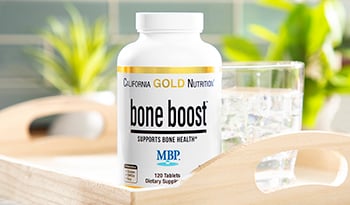Why Calcium Is Important for Children and Bone Health
DISCLAIMER:This blog does not intend to provide diagnosis...
- In this article:
- Calcium and Bone Health
- Other Benefits of Calcium
- Calcium Requirements
- Calcium Food Sources
- Vitamin D, Magnesium, and Calcium
- Takeaway

Calcium and Bone Health
While there is often a focus on calcium intake in older adults to prevent fractures, bone loss, and osteoporosis, calcium intake in children is arguably more important for longevity and long-term bone health than calcium supplementation in old age.
During childhood and adolescence, bones grow and eventually reach “peak bone mass.” This process is reliant on calcium intake. In fact, around 99% of all calcium in the body is found in the bones, and this calcium has to come from what we consume.
During adolescence, there is a three- to four-year period of peak bone-building where 40% of the adult bone mass is deposited. In girls, the peak is around 12.5 years of age, while in boys, the peak occurs at around 14 years of age. During these years, calcium demands are high, and if inadequate calcium consumption occurs, overall bone mass and strength may be compromised. This can lead to increased risks for osteoporosis and fractures later in life. If calcium intake is maintained, risks for bone issues can be minimized in adulthood.
Late childhood and early adolescence present a window of opportunity to build strong, healthy bones. If that opportunity is missed, peak bone mass can be compromised, with individuals having a greater propensity toward bone problems and bone loss as they age.
Other Benefits of Calcium
Beyond bone health in growing children, calcium is important for other reasons. Some of the latest data suggest that increased calcium modestly reduces blood pressure, especially in younger individuals. While the changes are modest, even small reductions in blood pressure can translate into significant health improvements. Lowering blood pressure by just two points can reduce the risk of death from stroke or heart disease by 10% and 7%, respectively.
As a nutrient, calcium is utilized for muscle contraction, nerve conduction, blood clotting, and numerous signaling systems. The mineral is necessary for normal physiological function, and due to the body’s needs, it is tightly regulated to maintain a reliable supply.
Calcium Requirements
For both boys and girls, calcium recommendations from the National Institutes of Health are the same through adolescence:
- 0-6 months 200 mg
- 7-12 months 260 mg
- 1-3 years 700 mg
- 4-8 years 1000 mg
- 9-13 years 1300 mg
- 14-18 years 1300 mg
However, worldwide, calcium recommendations vary by population. In Europe, recommendations for ages 1-3, 4-10, and 11-17 are 450 mg, 800 mg, and 1150 mg per day, respectively. Some data is even suggestive that Asian populations have better calcium absorption and do not require as much as other populations, which could reduce requirements for calcium in some Asian individuals.
Calcium recommendations are the highest throughout the lifespan from ages 9-18. Unfortunately, a lot of children do not meet these calcium recommendations. In the United States, teenage girls are most likely to miss recommendations, consuming 27% less calcium than recommended. In Asia, some estimates suggest that over 96% of children are not consuming adequate calcium. From the sparse data available, calcium consumption in Africa and South America appears to also indicate consumption levels around half of current recommended levels, putting numerous children at risk of low calcium intake and poor bone development.
Interestingly, however, there is a bit of a paradox. In many countries with lower calcium consumption, rates of osteoporosis and bone fractures later in life are lower. Termed “the calcium paradox,” it’s not fully understood why specific populations seem more resistant to bone problems, even with lower calcium consumption. It most likely has to do with the complexity of the different factors that influence bone loss as we age, including other dietary and lifestyle components.
Calcium Food Sources
To meet calcium dietary requirements, foods high in calcium need to be consumed regularly. Some of the richest sources of dietary calcium include:
- Low-fat milk, 610 mg in 16 oz.
- Canned sardines, 569 mg in 1 cup
- Plain yogurt, 297 mg in 8 oz.
- Whole sesame seeds, 281 mg in 1 oz.
- Cheese (mozzarella as an example), 273 mg in 1 oz.
- Cooked collard greens, 268 mg in 1 cup
- Cooked green soybeans, 261 mg in 1 cup
- Cooked spinach, 245 mg in 1 cup
- Canned salmon with skin and bones, 241 mg in 3 oz.
- Cooked beans (black-eyed peas), 211 mg in 1 cup
- Cooked kale, 195 mg in 1 cup
- Chia seeds, 179 mg in 1 oz.
- Cooked teff, 124 mg in 1 cup
- Cooked okra, 123 mg in 1 cup
- Cooked amaranth, 116 mg in 1 cup
- Baked Winter squash (acorn), 90 mg in 1 cup
- Almonds, 76 mg in 1 oz.
- Broccoli, 62 mg in 1 cup
While dairy foods are often highlighted for their role in calcium intake, other foods, including nuts and seeds, vegetables, fish (containing bones), and whole grains, can also be reliable sources.
If children are not meeting their calcium needs through diet, supplementation can be considered. Studies have found benefits for building bone with calcium supplements, although benefits in one study were increased when combined with physical activity and at earlier stages of puberty. A study on calcium citrate-malate supplementation found an increased bone mass of 24 grams yearly in adolescent females. The authors concluded that supplementation might help prevent future osteoporotic events.
Vitamin D, Magnesium, and Calcium
When it comes to calcium consumption and benefits, calcium is often emphasized alone, disregarding information around other vitamins and minerals that work in concert with the mineral. Vitamin D and magnesium are also critical to consider for bone health and in conjunction with calcium intake.
Vitamin D and Calcium
While consuming enough calcium is essential, vitamin D is also needed to absorb that calcium and utilize it in the body. A deficiency in either calcium or vitamin D during childhood can cause rickets—a condition in which bones are poorly mineralized and have low bone mass. In children with normal vitamin D levels, supplementation does not necessarily confer benefits, yet in children with low vitamin D levels, vitamin D can be beneficial.
And vitamin D also appears to be protective when combined with calcium supplementation. Over the last few decades, data has slowly been accumulating that suggests that calcium supplementation may increase risks for heart disease. The risk is only associated with calcium from supplements, as calcium from food does not appear to confer any risks.
The data also suggests that the increased heart disease risks with calcium supplementation may be mitigated by combining calcium supplementation with vitamin D. The combination may work as a hedge to protect from potential concerns that calcium supplementation alone may have adverse effects on heart health.
Magnesium and Calcium
When it comes to bone health, calcium often steals all the thunder. However, magnesium, another crucial mineral that is often under-consumed, is also critical for bone health.
Studies show that magnesium is commonly deficient. In some populations, upwards of 50% of individuals do not consume enough of the mineral. And yet the mineral is crucial for numerous functions throughout the body, including bone health. A small study on adolescent girls that were consuming low levels of magnesium found that magnesium supplementation significantly increased bone mass. In the study, magnesium supplementation improved bone mass most significantly in the hip. Studies later in life have also shown that magnesium has bone-sparing effects, helping to decrease bone loss as we age.
Takeaway
Calcium is a critical nutrient for developing bones from childhood through adolescence. Unfortunately, numerous children worldwide do not consume the required calcium from their diet, contributing to decreased bone mineral density and mass during development. This decreased bone mass can put them at risk of bone loss, osteoporosis, and bone fractures as they grow older. Calcium supplementation can help improve bone development when needed, as can the addition of vitamin D and magnesium when deficient in the diet.
References:
- Agostoni C, Canani RB, Fairweather-Tait S, et-al. Scientific Opinion on Dietary Reference Values for Calcium. EFSA J.2015;13(5):4101. doi:10.2903/j.efsa.2015.4101
- Aydin H, Deyneli O, Yavuz D, et al. Short-term oral magnesium supplementation suppresses bone turnover in postmenopausal osteoporotic women. Biol Trace Elem Res. 2010;133(2):136-143. doi:10.1007/s12011-009-8416-8
- Calcium intake of the U.S. population: What We Eat in America, NHANES 2009-2010. Dietary Data Brief. Food Surveys Research Group. Created September 2014. Accessed October 31, 2022. https://www.ars.usda.gov/ARSUserFiles/80400530/pdf/DBrief/13_calcium_intake_0910.pdf
- Carpenter TO, DeLucia MC, Zhang JH, et al. A randomized controlled study of effects of dietary magnesium oxide supplementation on bone mineral content in healthy girls. J Clin Endocrinol Metab. 2006;91(12):4866-4872. doi:10.1210/jc.2006-1391
- Chevalley T, Bonjour JP, Ferrari S, Hans D, Rizzoli R. Skeletal site selectivity in the effects of calcium supplementation on areal bone mineral density gain: a randomized, double-blind, placebo-controlled trial in prepubertal boys. J Clin Endocrinol Metab. 2005;90(6):3342-3349. doi:10.1210/jc.2004-1455
- Cormick G, Ciapponi A, Cafferata ML, Cormick MS, Belizán JM. Calcium supplementation for prevention of primary hypertension. Cochrane Database Syst Rev. 2022;1(1):CD010037. Published 2022 Jan 11. doi:10.1002/14651858.CD010037.pub4
- Greer FR, Krebs NF; American Academy of Pediatrics Committee on Nutrition. Optimizing bone health and calcium intakes of infants, children, and adolescents. Pediatrics. 2006;117(2):578-585. doi:10.1542/peds.2005-2822
- Hruby A, McKeown NM. Magnesium deficiency: what is our status? Nutr Today. 2016;51(3):121-128.
- Institute of Medicine (US) Committee to Review Dietary Reference Intakes for Vitamin D and Calcium; Ross AC, Taylor CL, Yaktine AL, et al., editors. Dietary Reference Intakes for Calcium and Vitamin D. Washington (DC): National Academies Press (US); 2011. Available from: https://www.ncbi.nlm.nih.gov/books/NBK56070/ doi: 10.17226/13050
- Lloyd T, Andon MB, Rollings N, et al. Calcium supplementation and bone mineral density in adolescent girls. JAMA. 1993;270(7):841-844.
- Ma XM, Huang ZW, Yang XG, Su YX. Calcium supplementation and bone mineral accretion in Chinese adolescents aged 12-14 years: a 12-month, dose-response, randomised intervention trial. Br J Nutr. 2014;112(9):1510-1520. doi:10.1017/S0007114514002384
- MyFoodData. Nutrient Ranking Tool. Accessed October 31, 2022. https://tools.myfooddata.com/nutrient-ranking-tool/Calcium/All/Highest/Household/Common/No
- Shlisky J, Mandlik R, Askari S, et al. Calcium deficiency worldwide: prevalence of inadequate intakes and associated health outcomes. Ann N Y Acad Sci. 2022;1512(1):10-28. doi:10.1111/nyas.14758
- Wang H, Wang D, Ouyang Y, Huang F, Ding G, Zhang B. Do Chinese children get enough micronutrients? Nutrients. 2017;9(4):397. Published 2017 Apr 18. doi:10.3390/nu9040397
- Weaver CM. Calcium requirements: the need to understand racial differences. Am J Clin Nutr. 1998;68(6):1153-1154. doi:10.1093/ajcn/68.6.1153
- Winzenberg T, Powell S, Shaw KA, Jones G. Effects of vitamin D supplementation on bone density in healthy children: systematic review and meta-analysis. BMJ. 2011;342:c7254. Published 2011 Jan 25. doi:10.1136/bmj.c7254
- Yang C, Shi X, Xia H, et al. The evidence and controversy between dietary calcium intake and calcium supplementation and the risk of cardiovascular disease: a systematic review and meta-analysis of cohort studies and randomized controlled trials. J Am Coll Nutr. 2020;39(4):352-370. doi:10.1080/07315724.2019.1649219

 By Dr. Scott Buesing, N.D.
By Dr. Scott Buesing, N.D.


